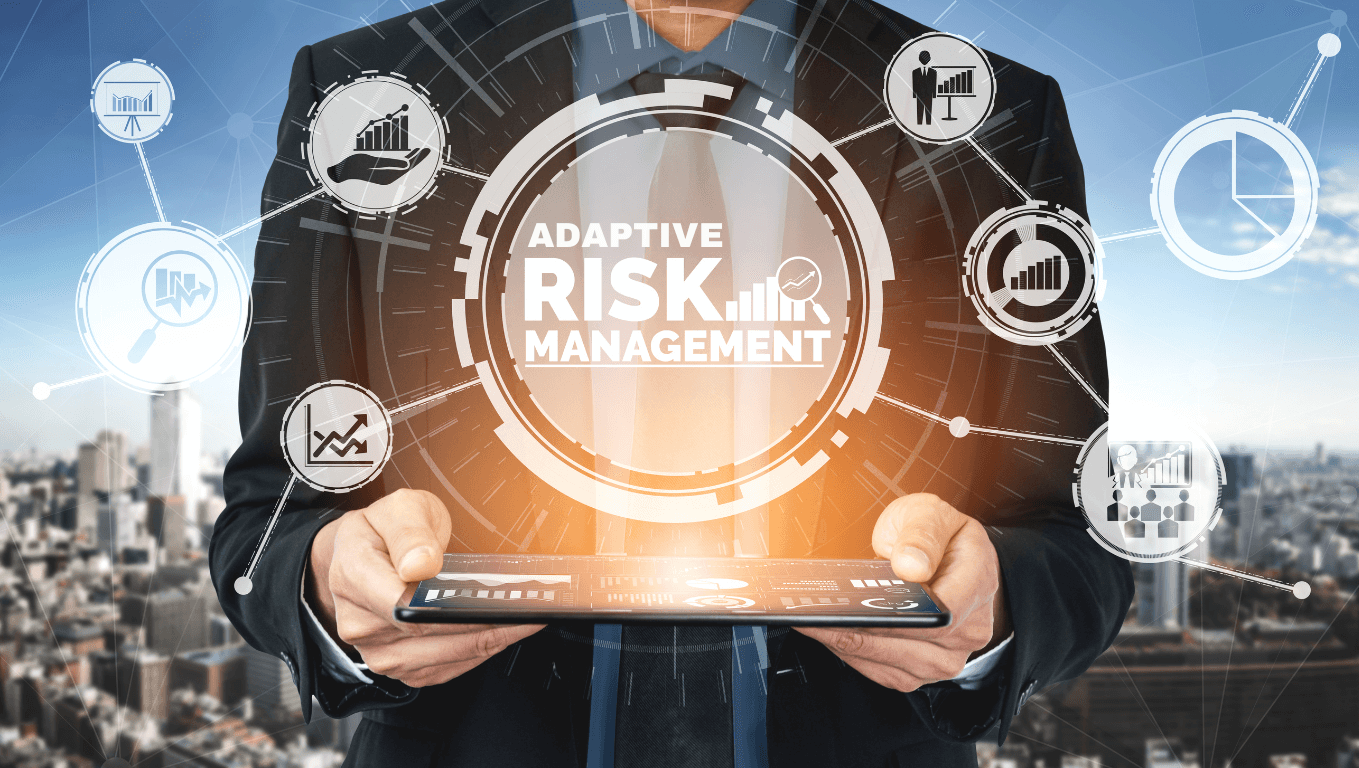
In today’s unpredictable world, managing risks effectively is more critical than ever. Traditional risk management strategies are no longer sufficient to navigate the complexities of modern business environments. That’s where Adaptive Risk Management (ARM) comes into play. ARM is an approach that not only identifies potential risks but also adapts to the changing landscape, ensuring resilience and sustainability.
“Risk comes from not knowing what you’re doing.”
Warren Buffett
By embracing Adaptive Risk Management, you can proactively address uncertainties, mitigate potential threats, and leverage opportunities. This dynamic approach empowers you to stay ahead of the curve, minimizing downtime, and maximizing success. Let’s delve into how ARM works and why it’s becoming an essential component of strategic planning.
Understanding Adaptive Risk Management: A Comprehensive Overview
Adaptive Risk Management (ARM) is an innovative approach to identifying, assessing, and mitigating risks in a dynamically changing environment. Unlike traditional risk management, which often relies on static frameworks, ARM pivots to more flexible strategies, considering the fluid nature of modern business ecosystems.
At its core, Adaptive Risk Management (ARM) uses machine learning and advanced data analytics to adapt in real-time. This involves constantly looking at risk data, checking threats based on user activities and behaviors, and changing response strategies as needed. Using these smart tools, organizations can stay ahead of potential issues.
An important aspect of ARM is its application within complex adaptive systems. These are networks where individual components or agents interact in a manner that impacts the whole system’s behavior. Traditional, rigid risk management methods often fall short in such environments due to their inability to respond swiftly to change. ARM, on the other hand, thrives on adaptability and continuous learning, making it particularly effective in volatile settings.
Implementing ARM requires rethinking the established risk governance frameworks. It demands updating policies and practices to be more fluid and responsive. This includes integrating risk assessment directly into decision-making processes. Such integration ensures that risk evaluation is not an afterthought but a core component of strategic planning.
For governments, ARM is especially crucial when planning for future climate and socioeconomic changes. Adaptive strategies enable policymakers to create flexible, resilient plans that can evolve with emerging challenges and insights. This foresight is indispensable in ensuring sustainable development and public safety.
In summary, Adaptive Risk Management represents a paradigm shift in how we approach uncertainty. It transforms risk management from a static practice into a dynamic, responsive system, leveraging technology to navigate the complexities of today’s world. By embracing ARM, organizations and governments alike can enhance their resilience, preparedness, and overall strategic agility.
The Core Principles of Adaptive Risk Management
Adaptive Risk Management (ARM) hinges on several key principles that set it apart from traditional risk management approaches. These principles are designed to enable organizations to effectively respond to an ever-changing risk landscape and ensure resilience in the face of uncertainty.
1. Dynamic Risk Evaluation
Unlike static risk assessments, ARM continuously evaluates risks using advanced techniques such as machine learning. This allows for real-time analysis and adaptation based on user activities and behaviors. It ensures that risk assessments are always current and reflective of the latest data.
2. Integration with Decision Making
ARM requires risk assessment to be deeply embedded in the decision-making process. By integrating risk evaluations directly into strategic planning and operational decisions, organizations can proactively manage potential threats rather than reactively addressing issues as they arise.
3. Flexible Risk Governance
The governance framework within ARM must be adaptive to accommodate changing risks. This involves updating policies, processes, and procedures regularly to ensure they remain effective and relevant. A flexible governance structure enables organizations to pivot quickly in response to new threats.
4. Minimal Human Intervention
Thanks to automation and machine learning, ARM can operate with minimal human interaction. This reduces the potential for human error and allows for faster response times. By leveraging technology, organizations can achieve a higher level of accuracy and efficiency in their risk management efforts.
5. Addressing Complex Adaptive Systems
ARM works well for managing risks in complex systems. These systems have interdependent and dynamic parts that need a flexible risk management approach. ARM gives you the tools to handle these complexities effectively.
How does adaptive risk management differ from traditional risk management?
The distinction between adaptive risk management and traditional risk management lies primarily in their approaches and capabilities. Traditional risk management often relies on static, predefined frameworks and checklists, evaluating risks on a fixed schedule or when specific events trigger a reassessment. This method can be inflexible and slow to respond to rapidly changing environments.
In contrast, adaptive risk management is a dynamic and continuous process. It leverages advanced technologies such as machine learning to analyze risk data in real time, evaluating risks based on user activities and behaviors. This allows for a more responsive and proactive approach. Adaptive risk management systems can automatically adjust to new information, requiring minimal human intervention and making it significantly more effective in addressing complex and evolving risks.
Moreover, adaptive risk management integrates risk evaluation directly into decision-making processes. This ensures that risk insights are continuously considered at every stage of decision-making, rather than being compartmentalized or treated as an afterthought. By doing so, it supports more informed and strategic decisions, improving overall organizational resilience.
Another key difference lies in the governance frameworks. Traditional risk management operates within rigid governance structures that can slow down decision-making and adaptation. Adaptive risk management, however, promotes flexible risk governance, allowing organizations to quickly adjust policies and strategies in response to new risks or changes in the external environment.
In summary, while traditional risk management is often reactive and static, adaptive risk management is proactive and dynamic. It leverages cutting-edge technology, requires minimal human intervention, and integrates seamlessly with decision-making processes, providing a robust framework for navigating today’s complex and uncertain risk landscape.
The Role of Flexibility in Risk Management
Flexibility plays a pivotal role in modern risk management practices. In today’s uncertain and volatile global business environment, having a flexible approach to risk management allows organizations to adapt quickly to unforeseen changes. This adaptability is key to survival and growth.
Traditional risk management often relies on static processes that can be slow to adapt. In contrast, adaptive risk management is dynamic, incorporating continuous monitoring and real-time adjustments to risk strategies. This enables organizations to stay ahead of potential threats and seize emerging opportunities.
Moreover, flexibility in risk management ensures that risk assessments are integrated into decision-making processes at all levels. This approach not only mitigates potential risks but also aligns risk management practices with an organization’s strategic goals, thus fostering resilience and innovation.
By adopting a flexible risk governance framework, organizations can reduce the need for extensive human intervention. Automated systems and AI-driven tools can swiftly evaluate risks and provide actionable insights, allowing for quicker, data-driven decisions.
In essence, the flexible nature of adaptive risk management allows it to address complex adaptive systems effectively. It brings together various risk management functions to transform their approach and capabilities, ultimately enabling more robust and proactive risk management.
For organizations aiming to thrive in an unpredictable market, incorporating flexibility into their risk management practices is not just beneficial—it’s essential.
Linking Risk Management to Adaptive Strategy
Adaptive risk management isn’t just a theoretical concept; it’s a strategic tool that propels organizations to thrive in uncertain environments. By tying risk management processes directly to adaptive strategies, you can ensure that your organization remains resilient and responsive to change.
Your adaptive strategy should incorporate real-time risk assessments and dynamic risk evaluation, enabling swift and informed decision-making. For instance, through incorporating machine learning algorithms, businesses can analyze vast datasets to predict potential risks more accurately and adjust strategies as necessary.
Furthermore, an updated risk governance framework is crucial. It allows your organization to be more flexible and agile in its approach, ensuring minimal human intervention. This, in turn, frees up human resources to focus on strategic decisions rather than operational risk assessments.
By embracing adaptive risk management, you can link risk management to adaptive strategies effectively, fostering a culture that not only anticipates risks but also turns them into strategic advantages.
How Adaptive Risk Management Supports Adaptive Strategy
In today’s rapidly changing business environment, the ability to quickly adapt is crucial for maintaining a competitive edge. This is where adaptive risk management plays a transformative role. By continuously evaluating and responding to emerging risks, it helps organizations align their risk management efforts with strategic objectives, ensuring a proactive rather than reactive approach.
Real-time Adaptation:
Adaptive risk management utilizes advanced technologies like machine learning to analyze vast amounts of data in real time. This capability allows for dynamic adjustment to strategies based on evolving risks, ensuring that your organization remains agile and can pivot as necessary to address new challenges.
Strategic Alignment:
One of the key benefits of adaptive risk management is its ability to seamlessly integrate with an organization’s strategic planning. It ensures that risk considerations are embedded in every strategic decision, providing a holistic view that enhances decision-making processes. This alignment minimizes the likelihood of unforeseen disruptions and maximizes strategic opportunities.
Enhanced Resilience:
Adaptive risk management contributes to overall business resilience by continuously updating risk profiles and response plans. This approach helps in identifying potential weaknesses and reinforcing them before they become critical issues, ensuring long-term strategic success.
Empowered Decision-making:
With risk data readily available and systematically evaluated, decision-makers are better equipped to make informed choices. This empowerment not only fosters confidence but also encourages a culture of proactive risk management, where identifying and addressing risks becomes a shared responsibility across the organization.
By supporting adaptive strategy through these mechanisms, adaptive risk management serves as a cornerstone for building a resilient, flexible, and forward-thinking organization prepared to thrive amid uncertainty.
Importance of adaptive risk management in adaptive strategy
Adaptive risk management is a cornerstone of any effective adaptive strategy. In an unpredictable world, businesses need to be agile and responsive to changes. This adaptability extends beyond mere reaction; it means anticipating, evaluating, and mitigating risks dynamically.
By making risk management an ongoing process rather than a static one, companies can stay ahead of potential threats. This proactive stance not only helps in safeguarding assets but also provides an edge over competitors who may be slower to react.
Moreover, adaptive risk management integrates deeply with business strategy, ensuring that all strategic decisions consider potential risks and opportunities. This alignment helps in creating a resilient organization capable of thriving in volatility.
Thus, adaptive risk management is not just a protective measure—it’s a strategic enabler that fosters innovation and long-term success.
Benefits of adaptive risk management in successful adaptive strategy
Adaptive risk management brings many benefits to businesses striving for a successful adaptive strategy. By incorporating this approach, organizations are better equipped to navigate the complexities of today’s ever-changing environment.
- Proactive Decision-Making: Adaptive risk management empowers leaders to make informed, proactive decisions. By continuously evaluating risks in real-time, companies can address potential issues before they escalate, ensuring stability and sustained growth.
- Resource Allocation: Effective resource allocation is crucial for any strategy. Adaptive risk management allows organizations to allocate resources where they are needed most, minimizing waste and maximizing efficiency.
- Transparency and Communication: With adaptive risk management, transparency within the organization increases. Clear communication channels are established, enabling all stakeholders to be aware of potential risks and the measures taken to mitigate them.
- Organization Reputation Improvement: By managing risks adeptly, organizations can protect and enhance their reputation. A robust risk management strategy demonstrates reliability and resilience, fostering trust among clients, partners, and investors.
- Enhanced Resilience: Adaptive risk management strengthens an organization’s resilience. It equips businesses with the agility to adapt to unexpected changes, ensuring they remain competitive and thrive even in uncertain times.
- Data-Driven Insights: Utilizing advanced technologies like machine learning, adaptive risk management provides data-driven insights. This helps organizations accurately assess risks and make strategic decisions based on comprehensive analysis.
Incorporating adaptive risk management into your adaptive strategy not only helps in addressing immediate challenges but also paves the way for long-term success and sustainability.
How Adaptive Risk Management Enhances Business Resilience
Linking risk management with an adaptive strategy is vital for enhancing a business’s resilience. This dynamic approach transforms risk management from a reactive process to a proactive one, enabling companies to anticipate and mitigate risks effectively.
Key Integrations of Adaptive Strategy and Risk Management:
- Continuous Monitoring: Utilizes real-time data analysis to identify and evaluate potential risks, ensuring timely responses.
- Machine learning (ML) and artificial intelligence (AI) lead the way in adaptive risk management. These technologies can look at large amounts of risk data, find patterns, and predict possible risk scenarios based on user activities and behaviors. This ability to predict helps businesses stay ahead, ready to handle risks before they grow.
- Automated Decision Making: Reduces human intervention, fostering quicker and more efficient risk management processes.
Combining adaptive strategies with robust risk management frameworks enables businesses to adapt to changes in the market and external environments. This adaptability is crucial in today’s fast-paced, ever-evolving landscape, ensuring a company remains robust and agile against unforeseen challenges.
Integrating Adaptive Risk Management into Business Strategy
Embedding adaptive risk management within your business strategy isn’t optional—it’s a necessity. When you integrate these dynamic principles into your strategic planning process, you’re preparing your organization to pivot effectively in response to market shifts and emerging threats. This holistic approach ensures that risk management isn’t a standalone activity but is entwined with your core aims and operations.
Start with Comprehensive Risk Assessment: Initially, perform a thorough risk assessment, which involves identifying potential risks and evaluating their impact. This assessment should be regularly updated to reflect new challenges and opportunities.
Embed Risk Considerations in Decision-Making: Make risk evaluation an integral part of your strategic decision-making processes. This means considering risk impacts in every significant decision, whether it involves market expansion, product launches, or technological investments.
Cultivate a Risk-Aware Culture: Embed a culture that prioritizes risk awareness and proactive management. Encourage every member of your organization to recognize and communicate potential risks. This helps foster an environment where adaptive risk management can thrive.
Utilize Technology for Real-Time Monitoring: Employ advanced analytics and AI-driven tools to monitor risks in real-time. These technologies can provide valuable insights, enabling your organization to respond swiftly and adequately to new threats.
Regularly Reevaluate and Adapt: Keep your risk management strategies dynamic by regularly reassessing them. The business landscape is fluid, so your risk management framework should be as well. Continual reevaluation ensures that your strategies stay relevant and effective.
Integrating adaptive risk management into your business strategy not only enhances resilience but also equips your organization to capitalize on new opportunities while mitigating potential downsides. This integrated approach fosters a robust, agile, and forward-thinking business environment.
Organizations with proactive risk management are 35% more likely to meet their strategic objectives.
Implementing Adaptive Risk Practices in Your Organization
Ready to bring adaptive risk practices into your business strategy? Here’s how you can start.
1. Foster a Risk-Aware Culture
Create a culture that values risk awareness. Encourage open talks about potential risks and treat risk-taking as a chance to learn. Your team should feel confident in identifying and discussing risks openly.
2. Leverage Advanced Analytics
Use advanced analytics to keep an eye on risks. Big data and machine learning can give you better insights into potential threats and help predict trends. A data-driven approach keeps your risk management strategies up-to-date.
3. Encourage Continuous Learning and Adaptation
Urge your team to stay informed about the latest in risk management and business intelligence. Continuous learning promotes an adaptive mindset, helping your organization stay responsive to new challenges and opportunities.
4. Develop Flexible Risk Mitigation Plans
Make sure your risk mitigation plans are adaptable. Flexibility is essential; adjust your plans based on real-time data and changing situations. This helps your organization stay agile and strong, even during unexpected crises.
5. Integrate Risk Management into Strategic Planning
Risk management should be a part of your overall strategic plan. Aligning your risk practices with your business goals ensures cohesive strategies and a unified path to success.
By following these steps, you can build a robust adaptive risk management framework that not only protects your organization from potential threats but also positions it to capitalize on new opportunities for growth and innovation.
50% of companies without adaptive risk management face significant operational challenges.
Potential challenges in implementing Adaptive Risk Management
Implementing Adaptive Risk Management (ARM) is not without its hurdles. While the benefits are substantial, there are several challenges organizations must navigate.
| Challenge | Description |
| Resistance to Change | One of the biggest challenges is resistance to change. Employees and managers used to traditional methods may |
| High Initial Investment | Adaptive Risk Management often uses advanced technologies like machine learning and AI. The initial cost can be high |
| Data Quality and Integration | ARM relies on data for accurate risk evaluation and decision-making. Ensuring this data is correct |
| Cybersecurity Concerns | As ARM systems often involve the use of cloud-based technologies and data analytics, they are potentially vulnerable to cybersecurity threats. Ensuring robust cybersecurity measures and continuously monitoring for vulnerabilities is crucial to safeguard sensitive risk data. |
| Constantly Evolving Risks | Adaptive Risk Management handles changing risks, so it must also adapt. Keeping up with fast risk changes can be tough. Organizations need to keep monitoring, learning, and adapting to stay ahead. |
| Complexity and Overwhelm | The adaptive framework can be complex. The large amounts of data and detailed analysis required can overwhelm |
Despite these challenges, the implementation of Adaptive Risk Management offers a transformative approach to managing uncertainties. By addressing these hurdles proactively, organizations can better position themselves to reap the significant benefits of adaptive strategies.
Future Trends in Adaptive Risk Management
Risk management and adaptive strategy go hand in hand. In an era where change is the only constant, linking the two ensures that organizations are not just reactive but proactive in navigating uncertainties. A seamless integration of risk management into an adaptive strategy allows businesses to adapt swiftly to changing environments, foresee potential challenges, and capitalize on emerging opportunities.
Think of adaptive strategy as your game’s playbook, and risk management as the tactics you use to respond to the opponent’s moves. By aligning these two, you create a cohesive approach that strengthens decision-making, enhances resilience, and drives sustainable growth. It’s about embracing agility and building a framework that can pivot when necessary, ensuring that risk assessment and strategic planning are not siloed processes but a unified course of action.
Today’s dynamic business landscape demands more than static plans. Embracing adaptive risk management within your strategy provides the flexibility needed to thrive amidst uncertainty. It’s the bridge that connects your long-term vision with the practical tools needed to manage risks effectively.
75% of organizations plan to invest in advanced risk management technologies within the next five years.
The Lasting Benefits of Adaptive Risk Management
Adaptive risk management revolutionizes how we approach uncertainty in business, integrating flexibility at its core. By embracing this strategy, organizations can not only anticipate and mitigate risks but also leverage them as opportunities for innovation and growth. The adaptive approach transforms traditional risk management from a rigid, reactive process into a dynamic, proactive strategy that aligns seamlessly with the ever-evolving business landscape.
Follow us on LinkedIn to get all the latest Adaptive Insights.



